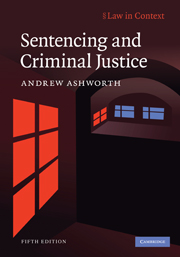Book contents
- Frontmatter
- Contents
- Preface
- Table of legislative measures
- Table of cases
- 1 An introduction to English sentencing
- 2 Sentencing and the constitution
- 3 Sentencing aims, principles and policies
- 4 Elements of proportionality
- 5 Aggravation and mitigation
- 6 Persistence, prevention and prediction
- 7 Equality before the law
- 8 Multiple offenders
- 9 Custodial sentencing
- 10 Non-custodial sentencing
- 11 Procedural issues and ancillary orders
- 12 Special sentencing powers
- 13 Conclusions
- Appendix: The Sentencing Council: provisions in the Coroners and Justice Act 2009
- References
- Index
1 - An introduction to English sentencing
Published online by Cambridge University Press: 05 June 2012
- Frontmatter
- Contents
- Preface
- Table of legislative measures
- Table of cases
- 1 An introduction to English sentencing
- 2 Sentencing and the constitution
- 3 Sentencing aims, principles and policies
- 4 Elements of proportionality
- 5 Aggravation and mitigation
- 6 Persistence, prevention and prediction
- 7 Equality before the law
- 8 Multiple offenders
- 9 Custodial sentencing
- 10 Non-custodial sentencing
- 11 Procedural issues and ancillary orders
- 12 Special sentencing powers
- 13 Conclusions
- Appendix: The Sentencing Council: provisions in the Coroners and Justice Act 2009
- References
- Index
Summary
Courts and crimes
Although some common law crimes remain, most of the offences in English criminal law were created by statute and have a statutory maximum penalty. For the purposes of trial, offences were divided into three categories by the Criminal Law Act 1977 – offences triable only on indictment, offences triable only summarily, and offences triable either way. The most serious offences (e.g. murder, rape) are triable only on indictment, at the Crown Court. A large mass of less serious offences is triable only summarily, in magistrates' courts. The middle category of offences triable either way comprises most burglaries, thefts and frauds. The first question in these cases concerns the defendant's intended plea: if the defendant indicates a plea of guilty, the magistrates must assume jurisdiction and proceed to sentence, unless they decide that their sentencing powers are insufficient. If the intended plea is not guilty, the defendant will be tried at a magistrates' court unless either the magistrates direct or the defendant elects to have the case tried at the Crown Court.
The Crown Court sits with a judge and jury. There are three levels of Crown Court centre: first-tier centres, where both civil and criminal cases are tried and where High Court judges and circuit judges preside; second-tier centres, where High Court judges or circuit judges preside but only deal with criminal cases; and third-tier centres, where circuit judges or recorders deal with criminal cases, being mostly offences triable either way.
- Type
- Chapter
- Information
- Sentencing and Criminal Justice , pp. 1 - 50Publisher: Cambridge University PressPrint publication year: 2010

